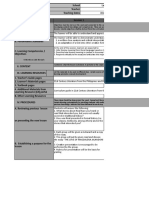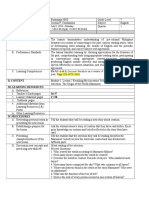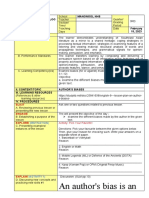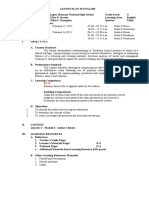0 ratings0% found this document useful (0 votes)
20 viewsDLL-English 8 Q3L16
DLL-English 8 Q3L16
Uploaded by
Wen J. Buela1. This document is a daily lesson log for an 8th grade English class taught by Mary Ann M. Bayle.
2. The lesson objectives are for students to show appreciation for Afro-Asian literature and exhibit understanding through comprehension questions about Southeast Asian literature.
3. The content of the lesson is the Thai folktale "Makato and the Cowrie Shell". Students will read the story silently and answer comprehension questions about the main character Makato.
Copyright:
© All Rights Reserved
Available Formats
Download as DOCX, PDF, TXT or read online from Scribd
DLL-English 8 Q3L16
DLL-English 8 Q3L16
Uploaded by
Wen J. Buela0 ratings0% found this document useful (0 votes)
20 views2 pages1. This document is a daily lesson log for an 8th grade English class taught by Mary Ann M. Bayle.
2. The lesson objectives are for students to show appreciation for Afro-Asian literature and exhibit understanding through comprehension questions about Southeast Asian literature.
3. The content of the lesson is the Thai folktale "Makato and the Cowrie Shell". Students will read the story silently and answer comprehension questions about the main character Makato.
Original Description:
Original Title
DLL-English_8_Q3L16
Copyright
© © All Rights Reserved
Available Formats
DOCX, PDF, TXT or read online from Scribd
Share this document
Did you find this document useful?
Is this content inappropriate?
1. This document is a daily lesson log for an 8th grade English class taught by Mary Ann M. Bayle.
2. The lesson objectives are for students to show appreciation for Afro-Asian literature and exhibit understanding through comprehension questions about Southeast Asian literature.
3. The content of the lesson is the Thai folktale "Makato and the Cowrie Shell". Students will read the story silently and answer comprehension questions about the main character Makato.
Copyright:
© All Rights Reserved
Available Formats
Download as DOCX, PDF, TXT or read online from Scribd
Download as docx, pdf, or txt
0 ratings0% found this document useful (0 votes)
20 views2 pagesDLL-English 8 Q3L16
DLL-English 8 Q3L16
Uploaded by
Wen J. Buela1. This document is a daily lesson log for an 8th grade English class taught by Mary Ann M. Bayle.
2. The lesson objectives are for students to show appreciation for Afro-Asian literature and exhibit understanding through comprehension questions about Southeast Asian literature.
3. The content of the lesson is the Thai folktale "Makato and the Cowrie Shell". Students will read the story silently and answer comprehension questions about the main character Makato.
Copyright:
© All Rights Reserved
Available Formats
Download as DOCX, PDF, TXT or read online from Scribd
Download as docx, pdf, or txt
You are on page 1of 2
GRADE 8 School Lecheria Integrated School Grade Level 8
DAILY Teacher Mary Ann M. Bayle Learning Area English
LESSON
Teaching Time 10:20-11:10; 11:10-12:00; 1:50-2:40 Quarter Third
LOG
Friday
Date: March 24, 2023
I. OBJECTIVES At the end of the lesson, the learners will be able to:
a. Show appreciation on Afro-Asian literature
b. Exhibit understanding through comprehension questions
The learner demonstrates understanding of: Southeast Asian literature as mirror to
a shared heritage ; coping strategies in processing textual information; strategies
A. Content Standards in examining features of a listening and viewing material; structural analysis of
words and propaganda techniques; and grammatical signals for opinion- making,
persuasion, and emphasis.
The learner transfers learning by composing and delivering a persuasive speech
based on an informative essay featuring use of properly acknowledged
B. Performance Standards
information sources, grammatical signals for opinion-making , persuasion, and
emphasis, and appropriate prosodic features, stance,and behavior.
C. Learning Competencies/Objectives Identify notable literary genres contributed by South and West Asian writers
(Write the LC Code for each.) EN8LT-IVb-13
II. CONTENT Makato and the Cowrie Shell (A Thai Folktale)
III. LEARNING RESOURCES
A. References
1. Teacher’s Guide pages
2. Learner’s Material pages
3. Textbook pages
4. Additional Materials from Learning LeaP Packet from SDO Tayabas by Buenas Princess P. Jalbuena and Michaella R.
Resource (LR) portal Rada
B. Other Learning Resources
IV. PROCEDURES
A. Reviewing previous lesson or presenting Preliminary Activities
the new lesson -Prayer
-Classroom Health and Safety Practices
-Checking of Attendance
B. Establishing a purpose for the lesson The teacher will ask students about their dreams and aspirations in life.
C. Presenting examples/instances of the new 1. Assume that the gold on the illustration is your dream. What will you feel if
lesson you have attained your goal in life?
2. Do you think it will be easy for you to reach your dream?
D. Discussing new concepts and practicing Learning Task 1: Play with the Elements!
new skills #1 Unscramble the jumbled letters using the given definition.
1. g t t i n S e _____ refers to place, time, weather condition, social condition,
and even mood or atmosphere.
2. P o l t _____ is the sequence of events in a story or play.
3. f l i c t C o n _____ is the sequence of events in a story or play.
4. r a c t e r C h a _____ is the person in a work of fiction and the
characteristics of a person.
5. t o i n P of w i e V _____ is the angle from which the story is told.
6. m e T h e _____ is the controlling idea or value in a piece of fiction.
E. Discussing new concepts and practicing
Read the story, “Makato and the Cowrie Shell” silently.
new skills #2
F. Developing Mastery
-
(Leads to Formative Assessment)
G. Finding practical applications of Valuing hardship and perseverance gives you the chance to make new choices
concepts and skills in daily living based on what matters; how you act, think, and feel; and what you can and can't
do.
H. Making generalizations and abstractions Literature from South and West Asia teaches students to learn about different
about the lesson experiences and cultures. Literary works of Afro-Asian tell people about the
unique struggles and successes of Afro-Asian people.
I. Evaluating learning Learning Task 4: Answer the following questions:
1. Describe Makato. What character traits does he possess?
2. Through inferring what the character says, does and thinks, one can recognize
the traits of a literary character. Cite lines, actions and thoughts which show
Makato‘s traits.
3. What were those changes in Makato‘s life after meeting the king? Enumerate.
4. Which of Makato‘s traits are similar to yours?
5. How would you nurture and enhance your positive traits? In what ways?
6. What lessons in life does the author want to convey to you?
J. Additional activities for application or
remediation
V. REMARKS
VI. REFLECTION
A. No. of learners who earned 80% on the
There are __________ out of ____________ students who earned 80% in the evaluation.
formative assessment
B. No. of learners who require additional There are __________ out of ____________ students who earned below 80% in the
activities for remediation evaluation and required additional activities.
C. Did the remedial lessons work? No. of
learners who have caught up with the
________ YES (_______ students) _________ NO (_________ students)
lesson
D. No. of students who continue to require There are __________ students who continue to undergo remediation.
E. Which of my teaching strategies worked
well? Why did these work?
F. What difficulties did I encounter which
my principal or supervisor can help me
solve?
G. What innovation or localized materials
did I use/discover which I wish to share
with other teachers?
Prepared by: Checked by: Noted by: Approved by:
MARY ANN M. BAYLE JONATHAN S. VILLANUEVA MARIA CIELO A. BATAANON CHARLENE C. ANGELES
Subject Teacher Master Teacher I, English HT II/ Subject Coordinator School Principal
You might also like
- Topic Sentence and Supporting DetailsDocument3 pagesTopic Sentence and Supporting DetailsAlfeo OriginalNo ratings yet
- GRADE 5 First Quarter Week 1-5Document69 pagesGRADE 5 First Quarter Week 1-5Jeclyn D. FilipinasNo ratings yet
- FormalistStructuralis ApproachDocument5 pagesFormalistStructuralis ApproachDesiree NicoleNo ratings yet
- Final Lesson Plan English 8-WALKTHROUGH March 12 J 2024Document8 pagesFinal Lesson Plan English 8-WALKTHROUGH March 12 J 2024Christine Jane JabonillaNo ratings yet
- The Tale of Ch'unyhang - Lesson PlanDocument4 pagesThe Tale of Ch'unyhang - Lesson PlanRo AnnNo ratings yet
- Exam - March 25, 2024Document5 pagesExam - March 25, 2024Jackielyn ToledoNo ratings yet
- QuizDocument5 pagesQuizAngelica PacnaNo ratings yet
- Eng 10-4Document2 pagesEng 10-4veronica dumanopNo ratings yet
- Grade 8 Lesson PlanDocument4 pagesGrade 8 Lesson PlanBrent Aren Bersabe SumadsadNo ratings yet
- Reciprocal Teaching Lesson PlanDocument7 pagesReciprocal Teaching Lesson Plan2004677No ratings yet
- Happiest Boy in The World DLLDocument4 pagesHappiest Boy in The World DLLRochelle Anne DomingoNo ratings yet
- Proud AsiansDocument1 pageProud AsiansKristelle Joy TapiaNo ratings yet
- Majada in Integrated School: Learning CompetenciesDocument5 pagesMajada in Integrated School: Learning CompetenciesEllaine LimosineroNo ratings yet
- Week 1 - October 29, 30, 31Document8 pagesWeek 1 - October 29, 30, 31Josenia ConstantinoNo ratings yet
- Historical ApproachDocument5 pagesHistorical ApproachDesiree NicoleNo ratings yet
- 3rd Quarter Test Grade 7Document1 page3rd Quarter Test Grade 7Mary Joy C. AdornaNo ratings yet
- Tan June Christopher A. English DLPDocument5 pagesTan June Christopher A. English DLPRonan EmpreseNo ratings yet
- Capsule Biography WK 1Document2 pagesCapsule Biography WK 1donna sabugaaNo ratings yet
- 21 STDocument9 pages21 STAnn TaclasNo ratings yet
- San Pedro National High School: Department of EducationDocument2 pagesSan Pedro National High School: Department of EducationBeverly CartagoNo ratings yet
- Week 5 July 6, 7, 8, 9, and 10Document16 pagesWeek 5 July 6, 7, 8, 9, and 10Josenia Constantino50% (2)
- RWS11 1 3ABnarrationdescriptionDocument2 pagesRWS11 1 3ABnarrationdescriptionQuenieMarielIlar100% (1)
- Outlining 2Document3 pagesOutlining 2Tane MBNo ratings yet
- DLP q3w3 Leggie THDocument4 pagesDLP q3w3 Leggie THMark Leggie Feliciano RontaleNo ratings yet
- Sawatdee Lesson PlanDocument4 pagesSawatdee Lesson PlanRo AnnNo ratings yet
- DLL Eng8 q1 Day 1 CotDocument2 pagesDLL Eng8 q1 Day 1 CotLORIE BROCOYNo ratings yet
- Daily Lesson Log in English 8Document4 pagesDaily Lesson Log in English 8Sheba Maral Fawas100% (2)
- DLL April 24, 2023Document4 pagesDLL April 24, 2023Ethel Kate ReyesNo ratings yet
- DLL Week8 PhilDocument3 pagesDLL Week8 PhilBacani Peejaay0% (1)
- Week 2 Day 1 GRADE 8Document2 pagesWeek 2 Day 1 GRADE 8Anonymous yElhvOhPnNo ratings yet
- Week 2 Day 1 GRADE 8Document2 pagesWeek 2 Day 1 GRADE 8Anonymous yElhvOhPnNo ratings yet
- D2 DLL Eng8 W1 Day4Document6 pagesD2 DLL Eng8 W1 Day4Jubing S. Dela RamaNo ratings yet
- Wawa National High School Grade Level G7 Rejoy O. Panganiban Learning Area EnglishDocument3 pagesWawa National High School Grade Level G7 Rejoy O. Panganiban Learning Area EnglishRej PanganibanNo ratings yet
- Wawa National High School Grade Level G7 Rejoy O. Panganiban Learning Area EnglishDocument3 pagesWawa National High School Grade Level G7 Rejoy O. Panganiban Learning Area EnglishRej PanganibanNo ratings yet
- Week 2 Day 1 GRADE 8Document2 pagesWeek 2 Day 1 GRADE 8Anonymous yElhvOhPnNo ratings yet
- DLP CO2. EnglishDocument8 pagesDLP CO2. EnglishrizaNo ratings yet
- Listening SkillsDocument7 pagesListening SkillsQueencyNo ratings yet
- DLP The Road Not TakenDocument5 pagesDLP The Road Not TakenEli's WorldNo ratings yet
- Creative Non Fiction Day 1 Week 5Document2 pagesCreative Non Fiction Day 1 Week 5Donna BulanayNo ratings yet
- LP Format 1 1Document6 pagesLP Format 1 1Ezequel Froi FagaraganNo ratings yet
- Lesson Plan in English 10Document2 pagesLesson Plan in English 10MARY ANN ATUPNo ratings yet
- DLP q3w3 Leggie WDocument4 pagesDLP q3w3 Leggie WMark Leggie Feliciano RontaleNo ratings yet
- I. Objectives A. Content StandardsDocument2 pagesI. Objectives A. Content StandardsMargielyn Tiburcio Marte - AngayNo ratings yet
- Feb 15Document5 pagesFeb 15Ellen BanaguasNo ratings yet
- English Lesson Plan Charater and ThemeDocument8 pagesEnglish Lesson Plan Charater and ThemeJasmin CaballeroNo ratings yet
- Oralcom 2Document4 pagesOralcom 2Roann Marie MadrestaNo ratings yet
- Clarify Meaning of Words Using DictionariesDocument3 pagesClarify Meaning of Words Using DictionariesLanilee IntaligandoNo ratings yet
- Clarify Meaning of Words Using DictionariesDocument3 pagesClarify Meaning of Words Using DictionariesLanilee IntaligandoNo ratings yet
- English-3-Cot 1Document3 pagesEnglish-3-Cot 1Donna Grace Ilayat100% (1)
- Tall TalesDocument18 pagesTall Talesapi-353798415No ratings yet
- (Week 3) August 12-16, 2024Document7 pages(Week 3) August 12-16, 2024Thei KwonNo ratings yet
- Final Demo LPDocument8 pagesFinal Demo LPHAHAHAHA GAMINGNo ratings yet
- Reader-Response ApproachDocument5 pagesReader-Response ApproachDesiree NicoleNo ratings yet
- DLP Historical Approach Day 1Document4 pagesDLP Historical Approach Day 1Robert RamosNo ratings yet
- DLP TemplateDocument6 pagesDLP TemplateLeah Erica VillaranteNo ratings yet
- DLL-21ST 2ND WeekDocument5 pagesDLL-21ST 2ND WeekrubielNo ratings yet
- 21st Century Literature LESSON LOGDocument2 pages21st Century Literature LESSON LOGEvaNo ratings yet
- Happily Never AfterDocument5 pagesHappily Never AfterMary Grace Santos50% (2)
- Div Week5 Q2Document8 pagesDiv Week5 Q2Roselle Macaraeg-FloresNo ratings yet
- DLL-English - 8 - Q3L23 - March 14Document2 pagesDLL-English - 8 - Q3L23 - March 14Wen J. BuelaNo ratings yet
- DLL ENG8 QUARTER3 - March11Document2 pagesDLL ENG8 QUARTER3 - March11Wen J. BuelaNo ratings yet
- DLL-English 8 Q4L35Document2 pagesDLL-English 8 Q4L35Wen J. BuelaNo ratings yet
- DLL-Q2-Week3 - ENG8 - Jan 3Document10 pagesDLL-Q2-Week3 - ENG8 - Jan 3Wen J. BuelaNo ratings yet
- Mapeh Dll-Nov 28Document2 pagesMapeh Dll-Nov 28Wen J. BuelaNo ratings yet
- Mapeh Dll-Dec.4 (Music Lesson 1)Document3 pagesMapeh Dll-Dec.4 (Music Lesson 1)Wen J. BuelaNo ratings yet
- BUMKT2602 Consumer Behaviour CD Sem 1 2013Document14 pagesBUMKT2602 Consumer Behaviour CD Sem 1 2013李冠莹No ratings yet
- Class Discussion: Adjective Grammar Focus: Comparative and SuperlativeDocument9 pagesClass Discussion: Adjective Grammar Focus: Comparative and SuperlativeVito Mediandra 2034No ratings yet
- Jelena MiljkovicDocument18 pagesJelena MiljkovicAleksandar JovicNo ratings yet
- Mini Lesson Plan OutlineDocument3 pagesMini Lesson Plan Outlineapi-241706205No ratings yet
- Problems Involving Circumference of Circles Lesson PlanDocument1 pageProblems Involving Circumference of Circles Lesson PlanJonathan RobinsonNo ratings yet
- SEMI-DETAILED LESSON PLAN For Grade 11 SDocument2 pagesSEMI-DETAILED LESSON PLAN For Grade 11 SPaulo MoralesNo ratings yet
- UML by ExamplesDocument7 pagesUML by ExamplesbanukomuNo ratings yet
- 90 Life Changing QuotesDocument6 pages90 Life Changing QuotesPao Paolo100% (2)
- Ergonomics PresentationDocument12 pagesErgonomics Presentationapi-614474957No ratings yet
- Disney's Former CEO, Bob Iger, Mastered This 1 Thing His Successor LacksDocument4 pagesDisney's Former CEO, Bob Iger, Mastered This 1 Thing His Successor LacksSheeba GraceNo ratings yet
- See Examples of Detailed Logic Models BelowDocument2 pagesSee Examples of Detailed Logic Models Beloweric blairNo ratings yet
- Diass LessonDocument17 pagesDiass LessonMina CayetanoNo ratings yet
- TensisDocument7 pagesTensisUlfah Maisyaroh100% (1)
- Motion Planning For Humanoid RobotsDocument27 pagesMotion Planning For Humanoid RobotsRajavardhan GoudNo ratings yet
- Lecture 2Document12 pagesLecture 2RMDNo ratings yet
- Assessment Strategies: Ma. Vanessa M. Cariaso Master Teacher I Masipit Elementary SchoolDocument26 pagesAssessment Strategies: Ma. Vanessa M. Cariaso Master Teacher I Masipit Elementary Schoolvaness cariasoNo ratings yet
- Lesson 1Document4 pagesLesson 1Mark Russell MangubatNo ratings yet
- Differentiated Learning Style-Based Lessons Towards The Improvement of Learners' Performance in English 5 at Bukal Elementary School, Buenavista II District, Schools Division of QuezonDocument9 pagesDifferentiated Learning Style-Based Lessons Towards The Improvement of Learners' Performance in English 5 at Bukal Elementary School, Buenavista II District, Schools Division of QuezonPsychology and Education: A Multidisciplinary JournalNo ratings yet
- How The Brain WorksDocument37 pagesHow The Brain WorksGerson Freire De Amorim FilhoNo ratings yet
- North South University: ENG 103 Final Assignment: Spring 2021 Time Allowed: 24 HoursDocument2 pagesNorth South University: ENG 103 Final Assignment: Spring 2021 Time Allowed: 24 HoursMd. Moin Uddin AbeirNo ratings yet
- Grade 2 Vocabulary CurriculumDocument2 pagesGrade 2 Vocabulary CurriculumBřï Ťť ÑëýNo ratings yet
- Big Data and Social Science-DikompresiDocument81 pagesBig Data and Social Science-DikompresiErna Vidia WatiNo ratings yet
- GuidelinesDocument12 pagesGuidelinesjohn stevenNo ratings yet
- Test Simple Past Present Perfect enDocument4 pagesTest Simple Past Present Perfect enAndurnache Alexandru100% (1)
- Xar 905 DissertationDocument15 pagesXar 905 DissertationPriya BalajiNo ratings yet
- Materi Congratulation Kelas X (Amel)Document15 pagesMateri Congratulation Kelas X (Amel)AAMNo ratings yet
- Learning To Coach: An Ecological Dynamics Perspective: International Journal of Sports Science & Coaching November 2022Document13 pagesLearning To Coach: An Ecological Dynamics Perspective: International Journal of Sports Science & Coaching November 2022kevinNo ratings yet
- Class 11 Chapter 6 Test Measurement and EvaluationDocument7 pagesClass 11 Chapter 6 Test Measurement and EvaluationImportant IdNo ratings yet
- Shs - Practical Research 2Document49 pagesShs - Practical Research 2Viv Tolosa SorianoNo ratings yet






























































































